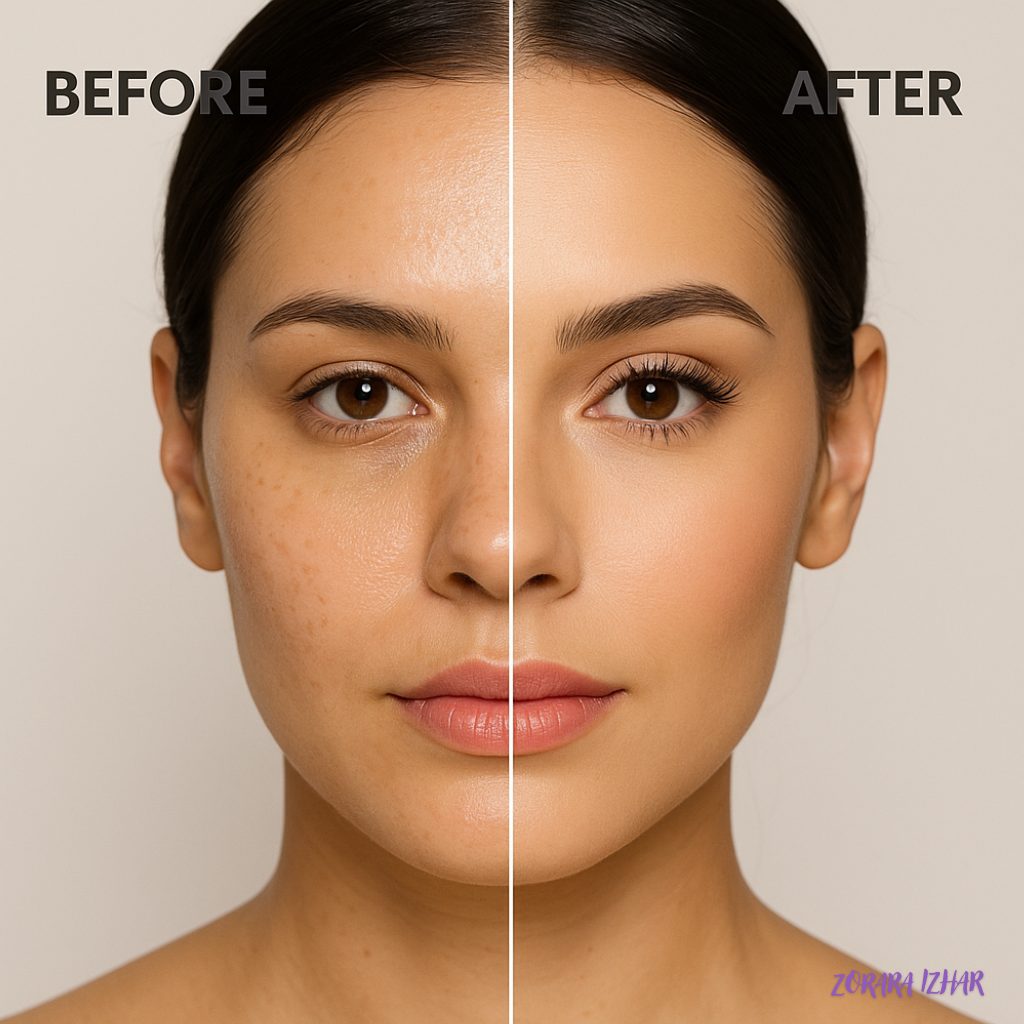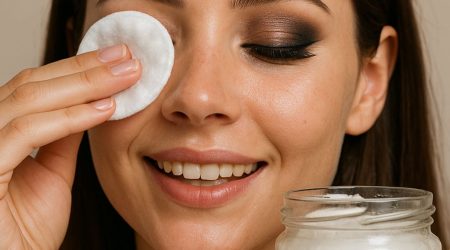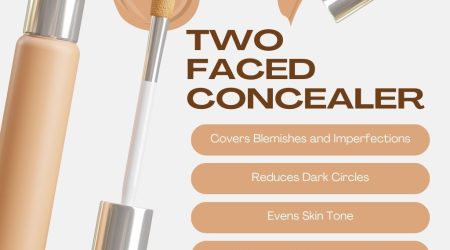Applying makeup on oily skin is often a challenge because the oiliness of the skin makes it difficult for makeup to last long, and the skin starts to look shiny. In such a situation, proper skin preparation is essential so that the makeup result is better, clearer and longer-lasting. This preparation step includes cleansing, toning, moisturizing and using a primer, which prepares the skin for makeup while controlling oiliness. In this introduction, we will review the important steps of skin prep for oily skin so that your makeup looks fresh and beautiful all day long.
Oily skin is skin that produces excess sebum. This natural oil actually moisturizes the skin, but when its amount exceeds the limit, complaints such as oiliness, large pores, acne and blackheads appear on the skin. The most common symptoms of oily skin include frequent shine of the skin during the day and rapid deterioration of makeup. This skin type is usually caused by genetics, hormonal changes or environmental factors such as heat and humidity. Proper care of oily skin and the use of the right products not only keeps oiliness under control but also makes the skin healthy and balanced.
Causes of Oily Skin
There can be many different causes of oily skin, which can affect a person at different stages of their life. The following factors are commonly associated with oily skin:
1.
Genetic factors: If someone in your family has oily skin, you may also inherit this trait.
2.
Hormonal changes: Hormonal changes during puberty, menstruation, pregnancy, or menopause can increase oil production.
3.
Weather effects: Hot and humid weather increases sebum production, which can make the skin more oily.
4.
Using the wrong skincare products: Too much moisturizing or using a cleanser that is too harsh can cause the skin to produce more oil to protect itself.
5.
Washing your face too often: Washing your face too often can dry out the skin, which in turn causes the skin to produce more oil.
6.
Diet: A diet high in fat, sugar or dairy can also sometimes affect the skin, although the effect varies from person to person.
7.
Stress: During times of stress, levels of the hormone cortisol increase, which can increase the amount of oil in the skin.
Common Makeup Challenges with Oily Skin
People with oily skin face several challenges when applying makeup, as oiliness prevents makeup from staying put on the skin. The following issues are commonly seen:
1. Makeup fading quickly: Foundations and bases on oily skin do not last long, and start to melt by the middle of the day.
2. Excessive shine on the face: The skin starts to shine very quickly, especially on the T-zone (forehead, nose and chin), which makes makeup look unnatural.
3. Makeup oxidation: Some foundations change color when mixed with oil, giving the skin a dark or orange appearance.
4. Pores that are prominent: The pores in oily skin are usually larger, and makeup fills them and becomes noticeable.
5. Acne aggravation: The wrong or heavy makeup products can clog oily skin, which can lead to acne or breakouts.
6. Cake-up: Repeated application of powder can make makeup look cakey and make the skin feel heavy.
This is why prepping your skin properly is key—not just for appearance but for long-term skin health.
Step 1: Cleanse with a Gentle Foaming Cleanser
The first step in cleansing your face is very important for oily skin, as excess oil, dirt, and makeup residue can clog pores. A gentle foaming cleanser is best for such skin, as it:
- Effectively removes excess oil from the skin without drying it out.
- Cleans pores and prevents blackheads.
- Leaves skin feeling refreshed and light.
- Reduces acne-causing bacteria.
Ingredients to Look for in a Cleanser
| Ingredient |
Benefit |
| Salicylic Acid |
Clears pores and controls oil |
| Niacinamide |
Balances sebum production |
| Tea Tree Oil |
Natural antibacterial |
| Zinc |
Regulates oil glands |
How Often Should You Cleanse?
- Morning and night: Twice daily is ideal.
- After sweating: Cleanse post-workout to avoid breakouts.
Step 2: Exfoliate ( but not too much)
In oily skin, dead skin cells and excess oil can build up on the skin and clog pores, leading to acne, blackheads, and dullness. Therefore, exfoliation is essential to:
- Remove dead skin cells,
- Unclog pores,
- Make skin feel soft and fresh.
However, over-exfoliating can be harmful, as it can make the skin more oily or sensitive.
The right way:
- Exfoliate 1 to 2 times a week.
- Use soft scrubs or chemical exfoliants such as salicylic acid, which are beneficial for oily skin.
- Avoid harsh, gritty scrubs, as they can irritate the skin.
Chemical vs. Physical Exfoliation
| Type |
Description |
Best For |
| Chemical |
Uses acids like AHA/BHA |
Deep pore cleansing |
| Physical |
Contains gritty particles |
Surface smoothing (use with caution) |
Best Exfoliants for Oily Skin
- BHA (Salicylic Acid) products
- Glycolic acid toners
- Enzyme-based exfoliants (gentler alternatives)
Use 2–3 times a week—more isn’t better!
Step 3: Use a Pore-Minimizing Toner
Using a toner is an important step to keeping your skin fresh and balanced after exfoliation, especially for oily skin. A pore-minimizing toner:
- Balances your skin's pH level,
- Helps close open pores,
- Removes excess oil and impurities from the skin's surface,
- Prepares your skin for makeup better.
Look for these ingredients in a toner:
- Vitamin C: Brightens skin.
- Niacinamide: Controls oil and minimizes pores.
- Witch Hazel: A natural estrogen that shrinks pores.
Avoid toners with alcohol, as they can dry out your skin and cause it to produce more oil.
Benefits of Using a Toner
- Reduces shine
- Preps skin for serums or moisturizers
- Refreshes without over-drying
Alcohol-Free Options for Sensitive Skin
Choose toners with:
- Witch hazel (natural astringent)
- Rose water
- Aloe Vera
 Step 4: Apply a Lightweight, Oil-Free Moisturizer
Step 4: Apply a Lightweight, Oil-Free Moisturizer
It’s a common misconception that oily skin doesn’t need moisturizer, when in fact, all skin types need moisture — it’s just a matter of choosing the right type of moisturizer.
Oil-free, lightweight moisturizer is best for oily skin, because it:
- Moisturizes skin without making it greasy,
- Helps balance oil production,
- Leaves skin soft, smooth, and ready for makeup,
- Keeps skin hydrated without clogging pores.
Moisturizer Myths for Oily Skin
- MYTH: Moisturizers make oily skin worse.
- TRUTH: Hydration controls oil by maintaining barrier health.
Recommended Ingredients
- Hyaluronic acid
- Glycerin
- Squalane
- Niacinamide
Avoid thick, creamy, or oily moisturizers, as they can make skin oily and cause breakouts.
Look for labels that say
non-comedogenic and
oil-free.
Step 5: Use a Mattifying Primer
Primer strengthens the base of makeup and makes it last longer. Using a
matte primer is especially important for oily skin, because it:
- Reduces shine and makes the skin matte,
- Controls excess oil and makes makeup last longer,
- Helps conceal pores and smooths the skin so that foundation can apply better.
Silicone-Based vs. Water-Based Primers
| Primer Type |
Best For |
| Silicone-Based |
Blurring large pores |
| Water-Based |
Sensitive or acne-prone skin |
How Primer Extends Makeup Wear
- Controls sebum production
- Acts as a barrier between skin and foundation
- Reduces oxidation
Avoid cream or gel-based primers as they can increase oiliness.
Step 6: Spot Treat Problem Areas
Oily skin can sometimes develop acne or spotted pimples in certain areas. In such cases, spot treatment is necessary to control the visible problems on the skin immediately.
This treatment depends on where on your skin there is a problem, and what type of treatment will be best for your skin.
What to use?
- Salicylic Acid: This is the best treatment for acne and pimples because it cleans pores and controls oil.
- Benzoyl Peroxide: This helps reduce acne bacteria.
- Tea Tree Oil: A natural ingredient that reduces acne and pimples.
- Let dry fully before continuing makeup.
- Use clay-based spot treatments on the T-zone.
Caution:
Sometimes more aggressive treatments can make the skin dry or sensitive, so apply these products only to the affected areas and do not apply too much.
Step 7: Blotting Before Makeup Application
Blotting means absorbing excess oil or grease before applying makeup. It is important to use blotting papers or clean tissues before applying makeup on oily skin to:
- Reduce oiliness, which helps makeup last longer.
- Keep the skin surface clean and smooth so that foundation or base can adhere better.
- Wipe away excess oil on shiny areas such as the T-zone (forehead, nose and chin).
Blotting Techniques and Tools
- Use blotting papers or a clean tissue.
- Lightly press—not rub—onto shiny areas.
Step 8: Let Skincare Set Before Makeup
Once you've completed all the steps of preparing your skin, such as cleansing, toning, moisturizing, and applying primer, the next important step is to give your skincare time to set. The goal is to allow your skincare products to fully absorb so that:
- Your skin is oil-free and smooth.
- Primers and moisturizers work better, and makeup lasts longer.
- Your makeup doesn't look cakey or unnatural.
What to do?
- Let your skincare products set on your skin for 2 to 5 minutes.
- If your skin starts to look shiny, use a bit of blotting paper to absorb excess oil.
Step 9: Choose the Right Foundation
Choosing the right foundation for oily skin is very important, because the wrong foundation can make your skin shine or make your makeup not stay on. In such a situation, you should choose a foundation that suits your skin type, so that your makeup lasts longer and looks natural.
What to choose?
- Oil-Free Foundation: This foundation is best for oily skin, as it controls oil and keeps makeup on for a long time.
- Matte Finish Foundation: This foundation makes your skin matte and reduces shine.
- Powder Foundation: If you have very oily skin, it is better to choose a powder foundation because it absorbs excess oil.
Matte vs. Dewy Foundation for Oily Skin
| Type |
Result |
| Matte |
Shine control and long wear |
| Dewy |
Avoid—can enhance oiliness |
Ingredients to Avoid
- Heavy oils
- Coconut oil
- Mineral oil
- Fragrances (can clog pores)
Choose foundations labeled
long-wear,
matte, and
oil-free.
Step 10: Finish with a Setting Spray or Powder
Once you have applied your makeup, the most important step for oily skin is to set your makeup so that it lasts and your face doesn't look shiny throughout the day. For this purpose, you can use setting powder or setting spray, or sometimes a combination of both is best..
Seal the deal with a setting product to lock in your look.
Choosing Between Setting Spray and Powder
| Product |
Benefit |
| Setting Powder |
Controls oil, sets foundation |
| Setting Spray |
Adds longevity, refreshes makeup |
Use both for extra staying power—powder first, then spray.
Setting powder:
- Locks your makeup in.
- Absorbs oil and eliminates shine.
- Apply especially to the T-zone (forehead, nose, a little bit).
Translucent Powder is best because it only absorbs oil without adding color.
Setting spray:
- Fixes your makeup so that it doesn't smudge.
- Some sprays provide a matte finish, which is suitable for oily skin.
- Hold the spray 6–8 inches away from your face and lightly spray it.
This setting step helps keep makeup looking fresh all day, especially when your skin tends to be oily.
FAQs
1.
Can oily skin skip moisturizer if using primer?
No—hydration is essential to keep skin balanced and reduce oil production.
2.
How can I stop my foundation from separating on oily skin?
Ensure your skin is cleansed, toned, and primed. Let skincare products absorb before applying foundation.
3. Is setting spray or setting powder better for oily skin?
Powder controls oil better, but using both gives the best results.
4. How often should I exfoliate oily skin before makeup?
2–3 times a week is ideal. Over-exfoliating can trigger more oil.
5. What’s the best primer ingredient for oily skin?
Silicones like dimethicone help blur pores and reduce oil production.
6. Can I use facial oils if I have oily skin?
Yes, lightweight oils like Squalane can help regulate sebum when used sparingly.
Conclusion
For makeup to last and look natural on oily skin, it’s important to take proper care and preparation of your skin. If you take each step thoughtfully such as cleansing with a gentle cleanser, lightly exfoliating, toning, applying an oil-free moisturizer, a mattifying primer, and using the right foundation you can not only keep your skin looking fresh but also make your makeup last longer.
Using a setting powder or spray as the final step completes your makeup and keeps shine under control. Remember, moderation, the right product selection, and consistency are the keys to great makeup results with oily skin.
 Step 4: Apply a Lightweight, Oil-Free Moisturizer
Step 4: Apply a Lightweight, Oil-Free Moisturizer



